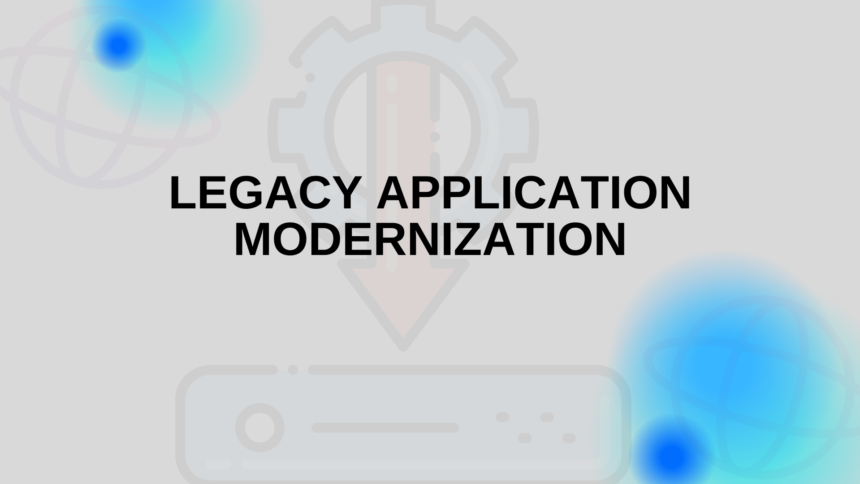Are your business apps lacking capabilities to meet customer/employee expectations? Perhaps you are using legacy applications. These outdated systems create bottlenecks in operations and cause frustration of your customers or employees. Another greatest fear for enterprises with legacy systems is data privacy challenges. Often, legacy apps do not keep the data secured. This is where legacy application modernization comes into the picture to rescue you.
Over the years, several trends have gained a foothold in the technology domain, and legacy app modernization is one of them. It is growing at a rapid pace, enabling enterprises to transform their applications. According to research, the entire market is expected to grow at a 16.7% CAGR – Grandviewresearch
Still, enterprises heavily rely on legacy applications for their operations. These legacy applications were developed decades ago, but now they lack the feasibility to integrate into today’s technologies, such as the cloud. We understand that these apps are the backbone of the enterprises, but these legacy apps pose multiple challenges, including:
- Legacy apps usually require frequent updates and particular skills to operate, causing huge operational expenses. High maintenance cost is one of the biggest challenges for the enterprises.
- Most of the legacy apps are vulnerable to security threats because they lack modern security updates and features. As we know, that data breaches and cyberattacks are very common in today’s digital era.
- Enterprises evolve according to the market demands, so they need scalable solutions that grow with them. When it comes to IT infrastructure, it should scale up according to your business needs. Here legacy apps fail to handle increasing workloads or integrating with new technologies.
These challenges demand immediate legacy application modernization solutions to stay competitive in the highly evolving market.
Latest Trends in Legacy Application Modernization
While modernizing your apps, you also need to keep an eye on the latest trends around legacy app modernization.
Cloud Migration and Hybrid Cloud
The most significant trend is cloud computing, which provides scalability, speed, and security to enterprises that legacy apps usually lack. Enterprises migrate their existing apps to cloud infrastructure to reduce hardware dependencies and enable faster app deployment into the systems. Apart from this, there are some enterprises adopting hybrid cloud models that have the flexibility to manage some apps on-remise infrastructure and others integrated into the cloud. With this approach, they plan to get the best of both worlds.
87% of businesses have already shifted to a multi-cloud model, while 72% are planning to migrate more apps to the hybrid-cloud model in the next two years – Flexera
Containerization and Microservices Architecture
Another trending technology in legacy apps modernization is containerization and Microservices. In containerization process, enterprises package legacy applications into containers and make it easy for them to run these packaged apps either in on-premise architecture or in the cloud. Kubernetes and Docker are two major platforms offering containerization solutions. These platforms make migration process easier and faster.
On the other hand, Microservices architecture breaks down legacy apps into independent and small services that can be easily deployed and maintained.
74% of organizations are either using or planning to microservices architecture – Gartner
API-First Modernization
Another very popular approach is modernization through APIs. It allows legacy apps to communicate with modern apps. Enterprises can easily leverage new apps’ functionalities and features without completely making changes in their existing infrastructure. This approach is suited for those enterprises that want incremental modernization to their apps, not all at once.
Organizations that adopted APIs approach for legacy app modernization have experienced a 63% faster time-to-market for new services and products – MuleSoft
Low-Code/No-Code Platforms
As its name suggests, with minimal coding efforts, enterprises can develop new apps and modernize their existing apps. Low code and no-code platforms enable enterprises to collaborate effectively and reduce the burden on IT teams. It democratizes the entire development processes. User adoption is a major challenge for most digital initiatives. By including business users in the development process, low-code/no-code technique helps you create intuitive, highly customizable applications and drive adoption.
According to Gartner over 70% of new applications will be developed by enterprises using low-code or no-code platforms by 2025.
Advantages of modernizing your legacy apps
Cost Savings
Modernizing your outdated systems and apps lowers operational and infrastructure costs. Most of the modern technologies such as cloud and containerizations require less energy and hardware.
Improved Efficiency
The core reason behind modernizing your legacy apps is improving its performances. Modernized apps required less updates and maintenance contributing into faster processing and efficient workflows.
Enhanced Security
Security is the most critical aspect for any IT infrastructure. Modernized systems incorporate high standard security protocols and guidelines to prevent cyberattacks and data breaches. Moreover, it helps in better data compliance.
Increased Scalability
Modernized applications are developed to handle growing demands of enterprises. Whether you want to scale up or down, modernized systems can easily handle those fluctuations.
Key Takeaways
- There are several ways enterprises can streamline their legacy modernization efforts – Low-code, APIs, Containerization, and more.
- It cuts infrastructure costs, improves efficiency, enhances resource allocation, and streamlines IT operations.
- Enterprises have started modernizing their legacy apps and gaining ROI






